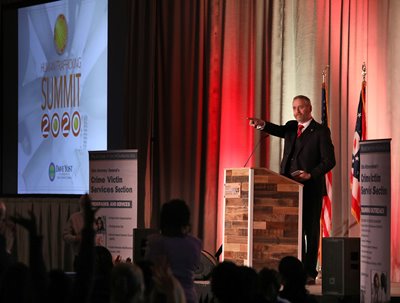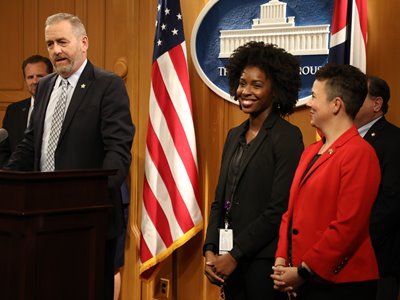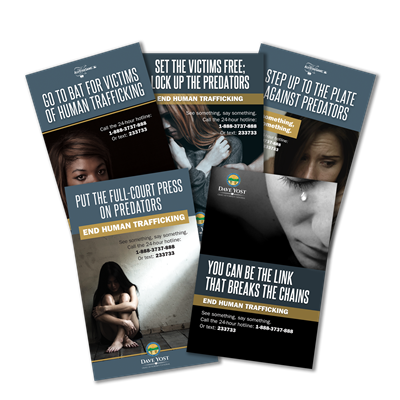 Attorney General Dave Yost speaks at his inaugural Human Trafficking Summit, held Jan. 9, 2020, to identify gaps in Ohio's human trafficking fight and share success stories, lessons learned and best practices. About 600 people attended.
Attorney General Dave Yost speaks at his inaugural Human Trafficking Summit, held Jan. 9, 2020, to identify gaps in Ohio's human trafficking fight and share success stories, lessons learned and best practices. About 600 people attended.
"Pimps play on three things: ignorance, low self-esteem and the desire to be loved,” says Ohio State University Professor Elaine Richardson, a survivor of human trafficking.
People with such vulnerabilities live in every part of Ohio, encapsulating why human trafficking is a problem affecting the whole state.
“The fact that you don’t see it doesn’t mean it’s not happening,” Attorney General Dave Yost said. “It means that it’s happening in the shadows. People don’t want it to be seen, and, for decades, our society was blind to the scale of the problem and blind to those trapped in it.”
During the first 11 months of 2019 alone, law enforcement task forces operating under the authority of the Ohio Organized Crime Investigations Commission rescued 110 trafficking victims and referred an additional 217 to services.
That’s almost 330 Ohioans combined who have not had control of their lives, their bodies or their time. And the number represents only the tip of the iceberg; Ohio is the fourth-worst state in the nation for human trafficking.
“We’ve seen that human trafficking doesn’t just affect strangers living in some far-off big city,” said Matt Hilbert, deputy director of OOCIC. “It is happening in suburbs, towns and rural communities, too, right now. Girls who live in my community are at risk.”
“And here’s a hard truth,” Yost said. “Society is not doing enough to end human trafficking. But that doesn’t mean we’re not trying like hell to help these modern-day slaves.”
The attorney general has created a plan of attack focused on fighting traffickers, decreasing demand and helping victims. Since entering the office on Jan. 14, 2019, Yost has pushed to change state laws, educate law enforcement officers and prosecutors, and make a difference for survivors.
The Ohio Peace Officer Training Academy offers human trafficking-specific courses, and one of Yost’s main tools is the new Human Trafficking Initiative, for which he has hired two experts in their fields to work full time to improve the human trafficking response in Ohio.
Jennifer Rausch, legal director of the initiative, and Jomel Aird, director of victim services, have been meeting with coalitions, prosecutors and multidisciplinary groups throughout Ohio.
“We have a lot of different people doing a lot of different things throughout the state,” said Rausch, a former leader in the Franklin County Prosecutor’s Office. “As we travel, we’re working to connect everybody to make sure people aren’t reinventing the wheel, to make sure that we can provide resources, too, and bring attention to groups that are doing things really well.”
On Jan. 9, various experts will share key information through the attorney general’s inaugural Human Trafficking Summit, where the focus will be to “send people home with ideas they can immediately use to improve the response in their own communities,” Rausch said.
Professor Richardson will share her story at the summit, and workshops will focus on how to create specialty court dockets, shelters for survivors and multidisciplinary teams that help victims and improve criminal case outcomes.
Aird, a victim advocate who previously worked with the Salvation Army and the Central Ohio Human Trafficking Task Force, said Yost plans to make the summit a yearly event.
“We want to plant that seed, start that conversation, but make it an ongoing conversation,” she said. “The more you know, the more you can do something about trafficking.”
 Above, from left: Attorney General Dave Yost and the Human Trafficking Initiative's Jomel Aird, director of victim services, and Jennifer Rausch, legal director of the initiative
Fighting traffickers
Above, from left: Attorney General Dave Yost and the Human Trafficking Initiative's Jomel Aird, director of victim services, and Jennifer Rausch, legal director of the initiative
Fighting traffickers
“A big myth that we should all recognize — there’s not some white van coming to a mall and kidnapping people to force them into trafficking,” Aird said. “A lot of traffickers come in as boyfriends or girlfriends. Under that guise, they build rapport, they build trust.”
They offer the seeming love and attention the girl or boy, or young woman or young man, doesn’t get at home. Or, with labor trafficking, they promise a better job and a better life.
By the time the trafficker flips the script, the victim already feels indebted. Emotional bonds are reinforced by chemicals released by the victim’s own body — the same hormones that pull families together when they survive hardship or that bond a mother to her newborn baby, Aird said.
“Today’s slave masters don’t use iron chains,” Yost said. “They use addiction, fraud and psychological manipulation.”
By the numbers
From January through November 2019, OOCIC task forces put up these numbers:
110
Victims rescued
217
Victims referred
to services
359
Human trafficking
tips received
239
People arrested in
related investigations
For example, seven people were recently indicted in Franklin County after an investigation by the Attorney General’s Office, Central Ohio Human Trafficking Task Force (an OOCIC effort) and Columbus police. The ring was accused of luring women into prostitution by offering drugs, gaining their trust and then intimidating them.
“Those invisible chains hidden in the mind can be harder to break than iron links,” Yost said.
Such tactics complicate the job for police and prosecutors trying to bring traffickers to justice.
Rausch and Aird described a recent case that succeeded only through a cooperative effort involving detectives, a court advocate, a victim advocate and prosecutors.
“The people the survivor trusted gradually introduced the other people to her, and by working together, we were able to get a really successful result,” Rausch said. “But that’s not how a lot of other felony-level cases would look moving through the system.”
“That survivor texted me last week,” said Aird, reading from her phone: “‘Thanks, Jomel, for everything because you are what keeps me going. I don’t know where I would be without you guys.”
Forming a multidisciplinary team is among the “best practices” shared by Yost’s Human Trafficking Initiative.
As a former prosecutor experienced in human trafficking cases, Rausch is compiling strategies for prosecuting trafficking-in-persons charges, educating jurors beginning with voir dire, and building cases that involve survivors who don’t present the way jurors probably expect them to.
“Some counties throughout the state are not charging trafficking in persons,” Rausch said. “They are more willing to charge compelling prostitution or promoting prostitution.”
Yet promoting prostitution is a fourth-degree felony that rarely results in prison time.
“And that’s a problem because the pimps are the criminals,” Yost said. “The mindset of law enforcement and the courts has turned, to recognize that the pimps’ slaves are really victims.”
To that end, Yost is pushing changes to Ohio law that would:
- Make it a crime to knowingly receive proceeds from a prostitute, with escalating penalties for each subsequent offense building up to three years in prison.
- Establish an online registry of pimps and human traffickers — those convicted of promoting prostitution — which would be maintained by the Attorney General’s Bureau of Criminal Investigation.
- Split the offense of “soliciting,” which now includes the buying and selling of sex, into two offenses. That way, buyers will face tougher penalties than the victims of human trafficking. “This is long overdue,” said Sen. Tim Schaffer, sponsor of the legislation in the Ohio Senate.
“I know when Dave Yost says additional legislation is important for his office to rescue victims of human trafficking and stem the demand in Ohio, he means it,” Schaffer said.
In the Ohio House, Reps. Cindy Abrams, Rick Carfagna and Jena Powell have partnered with Yost to sponsor the legislation.
Decreasing demand
“Basic economics works under the premise of supply and demand, and right now we have a demand problem in Ohio,” Yost said.
The attorney general has a multipronged effort to cut demand by catching, shaming and punishing people who attempt to buy sex, especially from children, and by making the public aware that prostitutes are often human trafficking victims.
In the first weapon in the arsenal, the Attorney General’s Office, including the BCI and OOCIC divisions, partners with dozens of law enforcement agencies for stings. For example:
- In September, in Operation Fourth and Goal, 32 law enforcement agencies and social services groups worked together to arrest 104 people in central Ohio. As a result, 24 men face felony charges for trying to buy sex with children, and 36 others were arrested for soliciting prostitutes.
- In May, the Mahoning Valley Human Trafficking Task Force — an OOCIC operation including officers from the Mahoning County Sheriff’s Office and Austintown, Middletown, Warren and Youngstown police departments — partnered with other agencies to arrest 16 men seeking to have sex with children in Canfield. In April and March, the same task force arrested 16 men in Youngtown and Warren.
“We could probably do a sting every night of the week and still arrest this many johns,” Yost said.
The johns’ names are made public and the stings are proclaimed, in large part, to shame the people who are arrested.
“The buyers of sex are never forced into it and are never victims,” Yost said. “They are sating their own appetites at the expense of another human being, predators who take what they want without regard to the costs of their feeding.
“But never underestimate the power of shame as a human motivator,” he said.
Taking that a step further, the online, publicly available registry proposed by the attorney general also would include the names and photos of those convicted of buying sex.
“What angers me as much as the act is the anonymity, that you can have these men go dehumanize these women, make it home in time for dinner with their families, and no one is the wiser,” Rep. Carfagna said.
Johns would stay on the registry for five years, according to the plan, which must be passed by the legislature and signed by the governor.
Yost also has proposed changes to state law so that people convicted of soliciting prostitutes would be sentenced to “john school,” specialized counseling for which they would pay, and up to a $1,500 fine for a first offense; 30 days in jail for a second offense; and six months for a third offense.
“The objective is to target all aspects of prostitution to ensure that we punish those who fuel this humanitarian crisis,” Sen. Schaffer said.
To make sure it’s impossible for Ohioans not to know that prostitutes are often being forced to sell themselves, the Attorney General’s Office has undertaken a public awareness campaign.

Posters have been hung at major events, including Major League Baseball All-Star games, NCAA March Madness games and the Ohio State Fair. Posters are made available by request to any event-holders (email
Publications@OhioAttorneyGeneral.gov).
Yost also has made the case that the movie
Pretty Woman has given society the wrong idea about prostitutes — that they’re free spirits making rational decisions about how to earn money.
“A prostitute is more likely a woman whose slave master is waiting in his car outside with a dose of heroin, a baseball bat or a knife,” Yost said.
Helping survivors
“The victims of human trafficking might be one of the most difficult populations to build trust with,” Yost said. “Folks who have been trafficked usually start out vulnerable to begin with — it’s how they get enticed into the life. And the trust they have given away has been abused.”
Rausch said studies have shown that, on average, it takes up to 10 contacts from advocates or law enforcement officers before victims of trafficking will accept help.
That means that, even though it can be frustrating that 217 people whom OOCIC task forces believed to be victims refused services in 2019, the contacts made (referrals to services) can still change lives — down the road.
“Victims carry a tremendous amount of guilt,” Rausch said, “that they, at some point, said yes to something, whether it was to go with the trafficker in the first place or to be in a relationship.”
Overcoming that takes work, as well as time and trust. Relationship building can be difficult for law enforcement agencies with more work than staffing and for advocacy coalitions that serve larger areas than their resources can cover. Also, not enough places in the state have courts with specialty dockets.
The need, clearly, is greater than the resources.
“Is it any wonder that, 154 years after the Civil War, we still haven’t eradicated slavery?” Yost said.
“My team wants to help folks create specialty dockets, develop prosecution strategy and create anti-human trafficking coalitions,” he said. “But before we can bring this knowledge to people, they have to recognize that the problem exists.
“They have to buy into the idea that when we work together, we can make a difference in saving our state’s most vulnerable citizens.”